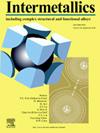Features engineered hardness and yield strength prediction of septenary refractory high-entropy alloys
IF 4.8
2区 材料科学
Q2 CHEMISTRY, PHYSICAL
引用次数: 0
Abstract
Refractory high-entropy alloys (HEAs) with more principal elements could have better mechanical properties, however, they also face greater challenges for designing because of larger exploration space of mechanical properties and complex physical interactions among elements. In this work, a machine learning (ML) model for the prediction of hardness and yield strength of septenary RHEAs was built. By comparing four ensemble models for 5-fold cross-validations, the CatBoost model was finally selected due to its better prediction performance. To overcome the shortcomings with limited datasets for RHEAs with increased number of principal elements, feature engineering was applied to expand the existing ordinary features. Multiple feature selection methods were combined in order to retain features that had a critical effect on hardness and yield strength. Pearson correlation coefficient was used to assess the degree of linear correlation among features. Thereafter, Shapley Additive Explanations (SHAP) was used to analyze the impact of each feature on prediction. Based on feature engineering, four RHEAs were recommended by the CatBoost model, and their mechanical properties were characterized. The results showed high accuracy for the hardness and yield strength prediction of septenary W-Nb-V-Zr-Cr-Mo-Ti RHEAs, where the WNb2V2Zr2Cr2MoTi alloy even demonstrated mean relative errors (MREs) of 0.18 % and 1.13 % for hardness and yield strength respectively. The present findings confirmed the effectiveness of feature engineering on the prediction of RHEAs with increased number of principal elements using ML models.

介绍了七阶耐火高熵合金的工程硬度和屈服强度预测
主元素较多的难熔高熵合金具有较好的力学性能,但其力学性能的探索空间较大,元素间的物理相互作用复杂,在设计上面临较大的挑战。在这项工作中,建立了一个机器学习(ML)模型,用于预测七种RHEAs的硬度和屈服强度。通过对比4种集成模型进行5次交叉验证,最终选择了CatBoost模型,该模型具有更好的预测性能。为了克服数据集有限、主元素数量增加的缺点,采用特征工程对现有的普通特征进行扩展。多种特征选择方法相结合,以保留对硬度和屈服强度有关键影响的特征。Pearson相关系数用于评价特征间的线性相关程度。然后,使用Shapley加性解释(SHAP)分析各特征对预测的影响。基于特征工程,通过CatBoost模型推荐了4种RHEAs,并对其力学性能进行了表征。结果表明,7种W-Nb-V-Zr-Cr-Mo-Ti合金的硬度和屈服强度预测精度较高,其中WNb2V2Zr2Cr2MoTi合金的硬度和屈服强度的平均相对误差(MREs)分别为0.18%和1.13%。目前的研究结果证实了特征工程在使用ML模型增加主元素数量时预测RHEAs的有效性。
本文章由计算机程序翻译,如有差异,请以英文原文为准。
求助全文
约1分钟内获得全文
求助全文
来源期刊

Intermetallics
工程技术-材料科学:综合
CiteScore
7.80
自引率
9.10%
发文量
291
审稿时长
37 days
期刊介绍:
This journal is a platform for publishing innovative research and overviews for advancing our understanding of the structure, property, and functionality of complex metallic alloys, including intermetallics, metallic glasses, and high entropy alloys.
The journal reports the science and engineering of metallic materials in the following aspects:
Theories and experiments which address the relationship between property and structure in all length scales.
Physical modeling and numerical simulations which provide a comprehensive understanding of experimental observations.
Stimulated methodologies to characterize the structure and chemistry of materials that correlate the properties.
Technological applications resulting from the understanding of property-structure relationship in materials.
Novel and cutting-edge results warranting rapid communication.
The journal also publishes special issues on selected topics and overviews by invitation only.
 求助内容:
求助内容: 应助结果提醒方式:
应助结果提醒方式:


